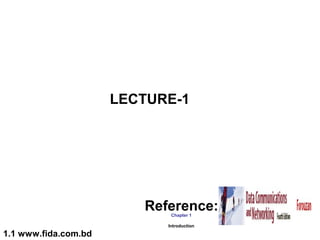
LECTURE-1 (Data Communication) ~www.fida.com.bd
- 1. LECTURE-1 Reference: Chapter 1 Introduction 1.1 www.fida.com.bd
- 2. 1-1 DATA COMMUNICATIONS The term telecommunication means communication at a distance. The word data refers to information presented in whatever form is agreed upon by the parties creating and using the data. Data communications are the exchange of data between two devices via some form of transmission medium such as a wire cable. Topics discussed in this section: Components Data Representation Data Flow 1.2
- 3. Figure 1.1 Five components of data communication 1.3
- 4. Figure 1.2 Data flow (simplex, half-duplex, and full-duplex) 1.4
- 5. 1-2 NETWORKS A network is a set of devices (often referred to as nodes) connected by communication links. A node can be a computer, printer, or any other device capable of sending and/or receiving data generated by other nodes on the network. Topics discussed in this section: Distributed Processing Network Criteria Physical Structures Network Models Categories of Networks Interconnection of Networks: Internetwork 1.5
- 6. Figure 1.3 Types of connections: point-to-point and multipoint 1.6
- 7. Figure 1.4 Categories of topology 1.7
- 8. Figure 1.5 A fully connected mesh topology (five devices) 1.8
- 9. Figure 1.6 A star topology connecting four stations 1.9
- 10. Figure 1.7 A bus topology connecting three stations 1.10
- 11. Figure 1.8 A ring topology connecting six stations 1.11
- 12. Figure 1.9 A hybrid topology: a star backbone with three bus networks 1.12
- 13. Figure 1.10 An isolated LAN connecting 12 computers to a hub in a closet 1.13
- 14. Figure 1.11 WANs: a switched WAN and a point-to-point WAN 1.14
- 15. Figure 1.12 A heterogeneous network made of four WANs and two LANs 1.15
- 16. 1-3 THE INTERNET The Internet has revolutionized many aspects of our daily lives. It has affected the way we do business as well as the way we spend our leisure time. The Internet is a communication system that has brought a wealth of information to our fingertips and organized it for our use. Topics discussed in this section: A Brief History The Internet Today (ISPs) 1.16
- 17. Figure 1.13 Hierarchical organization of the Internet 1.17
- 18. 1-4 PROTOCOLS AND STANDARDS In this section, we define two widely used terms: protocols and standards. First, we define protocol, which is synonymous with rule. Then we discuss standards, which are agreed-upon rules. Topics discussed in this section: Protocols Standards Standards Organizations Internet Standards 1.18
Editor's Notes
- 1.#
- 1.#
- 1.#
- 1.#
- 1.#
- 1.#
- 1.#
- 1.#
- 1.#
- 1.#
- 1.#
- 1.#
- 1.#
- 1.#
- 1.#
- 1.#
- 1.#
- 1.#
